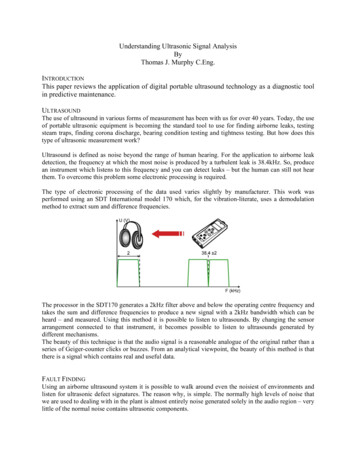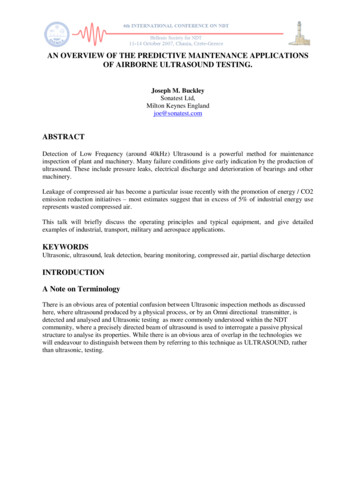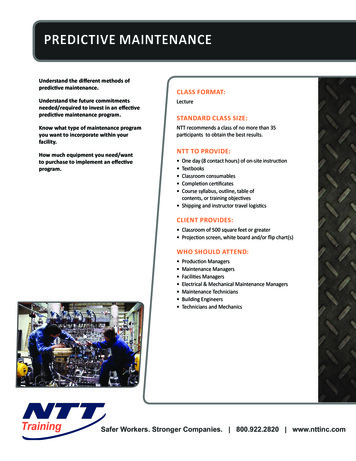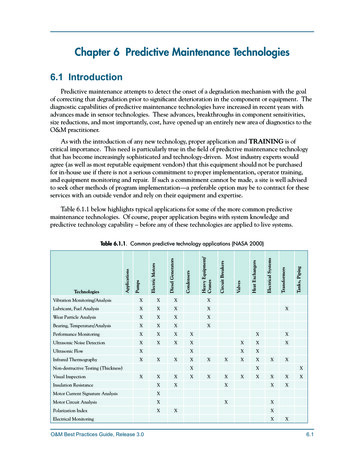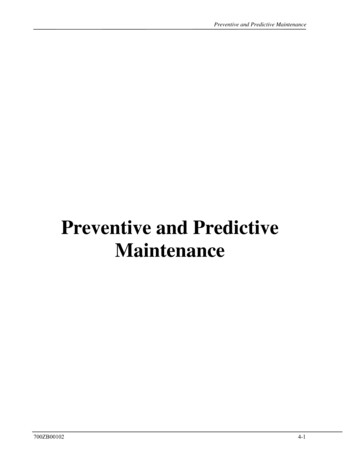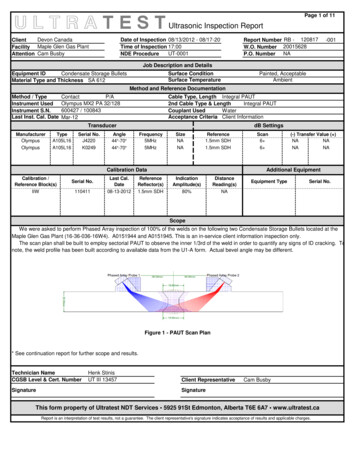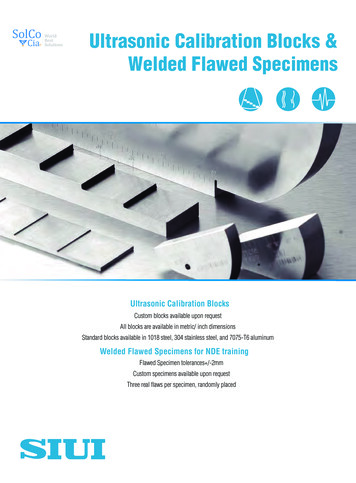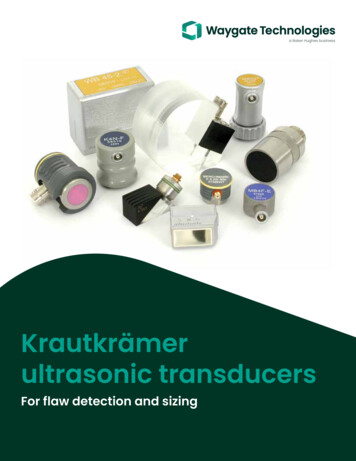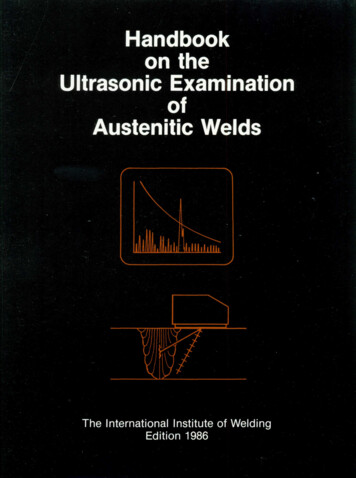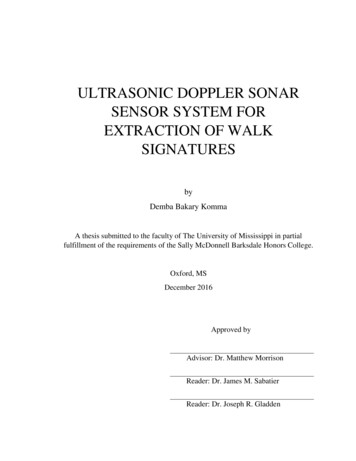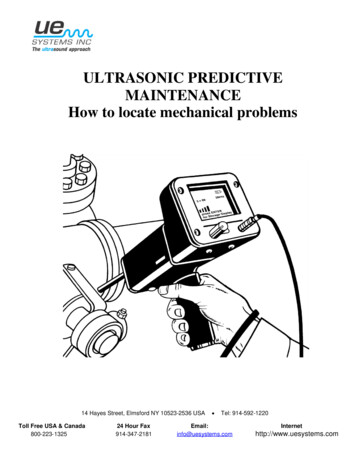
Transcription
ULTRASONIC PREDICTIVEMAINTENANCEHow to locate mechanical problemsearly14 Hayes Street, Elmsford NY 10523-2536 USAToll Free USA & Canada800-223-132524 Hour Fax914-347-2181 Tel: /www.uesystems.com
MONITORING BEARING WEARUltrasonic inspection and monitoring of bearings is by far the most reliable method fordetecting incipient bearing failure and conditions such as lack of lubrication. Theultrasonic warning appears prior to a rise in temperature or an increase in low frequencyvibration levels. Ultrasonic inspection of bearings is useful in recognizing:a. The beginning of fatigue failure. b. Brinelling of bearing surfaces. c. Flooding of orlack of lubricant.In ball bearings, as the metal in the raceway, roller or ball elements begins to fatigue, asubtle deformation begins to occur. This deforming of the metal will produce irregularsurfaces, which will cause an increase in the emission of ultrasonic sound waves.An indication of bearing failure is noted by an increase in amplitude of a monitoredultrasonic frequency over the original (baseline) reading. As an example, when a readingexceeds a baseline by 8 dB with no substantial change in the sound quality, it can indicatelack of lubricant. If the reading exceeds a baseline by 12 dB, it can be assumed that thebearing has entered the beginning (incipient stage) of the failure mode.This information was originally discovered through experimentation performed byNASA on ball bearings. In tests performed while monitoring bearings at frequenciesranging from 24 through 50 kHz, they found that the changes in amplitude indicateincipient (the onset of) bearing failure before any other indicators including heat andvibration changes. An ultrasonic system based on detection and analysis of modulationsof bearing resonance frequencies can provide subtle detection capability, whereasconventional methods are incapable of detecting very slight faults. As a ball passes over apit or fault in the race surface, it produces an impact. A structural resonance of one of thebearing components vibrates or "rings" by this repetitive impact. The sound produced isobserved as an increase in amplitude in the monitored ultrasonic frequencies of thebearing. The sound quality of these changes can also be heard through headphones.Brinelling of bearing surfaces will produce a similar increase in amplitude due to theflattening process as the balls get out of round. These flat spots also produce a repetitiveringing that is detected as an increase in amplitude of monitored frequencies.The ultrasonic frequencies detected by an ultrasonic translator such as the Ultraprobe ,are reproduced as audible sounds. This "heterodyned" signal can greatly assist a user indetermining bearing problems. The heterodyned signal may be analyzed through spectralanalysis software or by connecting the instrument to a vibration analyzer. Whenlistening, it is recommended that a user become familiar with the sounds of a goodbearing.A good bearing is heard as a rushing or hissing noise. Crackling or rough sounds indicatea bearing in the failure stage. In certain cases a damaged ball can be heard as a clickingsound whereas a high intensity, uniform rough sound may indicate a damaged race oruniform ball damage. Loud rushing sounds similar to the rushing sound of a good bearingonly slightly rougher can indicate lack of lubrication. Short duration increases in the3
sound level with "rough" or "scratchy" components indicate a rolling element hitting a"flat" spot and sliding on the bearing surfaces rather than rotating.If any of these conditions are detected, more frequent examinations should be scheduled.Data should be collected to note and trend decibel rises. In addition the bearing soundshould be analyzed using spectral analysis software or by connecting the ultrasoundinstrument to a vibration analyzer. Some instruments, such as UE Systems’ Ultraprobe10,000 have on-board sound recording, which enables users to download sound samplesvia a compact flash card to a computer.These sound samples can be reviewed in UE Spectralyzer spectral analysis software.Sound samples can be observed and heard in real time as they are played in either aspectral view or a time series view.Spectra of a Good BearingSpectra showing fault harmonicsDETECTING BEARING FAILUREThere are two basic procedures of testing for bearing problems: Comparative andHistorical. The Comparative Method involves testing two or more similar bearings and"comparing" potential differences. Historical Method testing requires monitoring aspecific bearing over a period of time to establish its history and to note any deviations ineither sound quality, decibel levels or both, which allows for early detection andcorrection.FOR COMPARATIVE TEST1.Use Contact (Stethoscope) probe. This probe uses a metal rod which acts as awave guide to carry the ultrasounds of the bearing to the instrument.2.Select desired frequency (consider using 30 kHz.).3.Select a "test spot" on the bearing housing and mark it for future; touch that spotwith the Contact Module. In ultrasonic sensing, the more mediums or materialsultrasound has to travel through, the less accurate the reading will be. Therefore, besure the Contact Probe is actually touching the bearing housing. If this is difficult,touch a grease fitting or touch as close to the bearing as possible.4
4.Approach the bearings at the same angle, touching the same area on the bearinghousing.5.Reduce sensitivity to hear the sound quality more clearly.6.Listen to bearing sound through headphones to hear the "quality" of the signal forproper interpretation.7.Select same type bearings under similar load conditions and same rotational speed.8.Compare differences of meter reading and sound quality.FOR BEARING HISTORY TRENDING:Before starting with the Historical Trending method for monitoring bearings, theComparative method must be used to determine a baseline.1.Use basic procedure as outlined above in steps 1-8 above.2.Record the data for future reference. Some digital ultrasonic instruments have onboard data logging which facilitate the data gathering and data entry process. UESystems offers freeware called Ultratrend DMS for ultrasonic data management. Fora free copy visit their web site: www.uesystems.com.3.Compare this information with previous data. On all future tests, adjust thefrequency to the original level.If the decibel level has moved up 12 dB over the base line accompanied by a changein sound quality, it may indicate the bearing has entered the incipient failure mode.Lack of lubrication is indicated by an 8 dB increase over baseline. It is usually heardas a loud rushing sound. If lack of lubrication is suspected, add lubricant whileobserving the meter. Add a little at a time until the dB level drops to baseline. Oruse UE’s Ultraprobe 201 Grease Caddy to listen as the grease is applied. If readingsdo not go back to original levels and remain high, consider bearing to be on the wayto the failure mode and recheck it frequently.Lack of Lubrication:To avoid lack of lubrication, note the following:1. As the lubricant film reduces, the sound level will increase. A rise of about 8dB over baseline accompanied by a uniform rushing sound will indicate lackof lubrication.2. When lubricating, add just enough to return the reading to base line.Use caution. Some lubricants will need time to uniformly cover the bearing surfaces.Lubricate a small amount at a time.5
DO NOT OVER-LUBRICATEOver-Lubrication:One of the most common causes of bearing failure is over-lubrication. The excesspressure of the lubricant often breaks, or “pops” bearing seals or causes a build-up ofheat, which can create stress and deformity.To avoid over-lubrication:1. Don't lubricate if the base line reading and base line sound quality is maintained.2. When lubricating, use just enough lubricant to bring the ultrasonic reading tobaseline.3. As mentioned above, use caution. Some lubricants will need time to uniformlycover the bearing surfaces.SLOW SPEED BEARINGSMonitoring slow speed bearings (below 200 RPM) is possible with an ultrasonictranslator. Due to the sensitivity range and the frequency tuning, it is quite possible tolisten to the acoustic quality of bearings. In extremely slow bearings (less 15 RPM), it isoften necessary to disregard the display and listen to the sound of the bearing. In theseextreme situations, the bearings are usually large and greased with high viscositylubricant. Most often low-level sound will be heard, as the grease will absorb most of theacoustic energy. If a high level sound is heard, usually a crackling sound, there is someindication of deformity occurring.On most other slow speed bearings, it is possible to set a base line and monitor asdescribed.VIBRATION ANALYZER (FFT INTERFACE)An ultrasonic translator such as the Ultraprobe can be connected to a vibration analyzerto enhance the diagnostic process. The connection is done through the headphone(heterodyned) jack. This enables a vibration analyzer to receive the heterodyned,(translated) sound information, which can be used to monitor and trend bearings,including low speed bearings. It can also extend the use of the analyzer to record all typesmechanical information such as leaking compressor valves, cavitation, gear wear, etc. Ifno vibration analyzer is available, record the sounds and play them back on a PC througha spectral analysis software such as UE Spectralyzer.3. GENERAL MECHANICAL TROUBLE SHOOTINGAs operating equipment begins to fail due to component wear, breakage or misalignment,ultrasonic shifts occur. The accompanying sound pattern changes can save time and6
guesswork in diagnosing problems if they are adequately monitored. Therefore, anultrasonic history of key components can prevent unplanned downtime. And just asimportant, if equipment should begin to fail in the field, an ultrasonic translator can beextremely useful in trouble shooting problems for condition analysis.Trouble Shooting/Condition Analysis: 1. Use the Contact (Stethoscope) Module. 2. Iffrequency tuning is available, try 30 kHz. 3. Touch test area(s): listen throughheadphones and observe the meter/display panel. 4. Adjust Sensitivity until mechanicaloperation of the equipment is heard clearly 5. Probe equipment by touching varioussuspect areas. 6. To focus in on problem sounds, while probing, reduce sensitivitygradually to assist in locating the problem sound at its' loudest point.Monitoring Operating Equipment: In order to understand and keep ahead of potentialproblems in operating equipment, it is necessary to establish base data and observe shiftsin that data. This can be accomplished by data logging readings directly into theinstrument or by recording sounds via a Compact Flash Card or a recording device.NOTE: In diagnosing any type of mechanical equipment, it is important to understandhow that equipment operates. Being able to interpret sound changes is dependent on abasic understanding of the operations of the particular equipment being tested. As anexample, in some reciprocating compressors, the diagnosis of a valve problem in the inletmanifold is dependent on recognizing the distinctive clicking sound of a good valve vs.the muffled click of a valve in a "blow-by" mode.Good compressor valveBad compressor valveIn gearboxes, before missing gear teeth may be detected as an abnormal click, the normalsounds of gears must be understood.Missing gear teeth7
ACCESSABILITY ISSUESAccessibility issues: there may be situations in which it may be difficult to gain access tosome bearings. For example, there may be a complex machine where a bearing is embeddedin an area where only a lube tube is extended outside the casing. If the lube tube is aconductive metal such as copper, the bearing can still be tested and a lubrication action levelset. If the fitting is of a non-sound conductive material such as plastic, a separate conductivemetallic wave guide can be installed so that the bearing can be monitored. The wave guidecan be isolated from structure borne noise of the machine (the mounting point) via rubberisolation material. Should it not be possible to place a wave guide, there s an alternativesolution. A transducer can be permanently mounted on the bearing housing and a cable run toan opening. The cable can be attached to a specialized connector that can be “plugged-in” tothe ultrasonic sensor, as shown below.ULTRASOUND ADVANTAGESThe advantages of ultrasound condition monitoring are many. Users can hear in real-time the sounds of operating equipment Ultrasound is a localized signal, which helps operators identify a sound source Ultrasound provides early warning indications of failure conditions Heterodyned sound samples can be recorded and analyzed on a PC Sound samples can be both heard in real time when analyzed on a PC Sound samples can be viewed on Vibration Analyzers, providing high resolution Ultrasound will detect lack of lubrication & prevent over lubrication Ultrasound instruments are extremely effective for Condition-Based Lubricationprograms Ultrasound is very effective for monitoring slow speed bearings Ultrasound is very effective for monitoring bearings of all speeds Software provides important data for, trend reports, alarm grouping and analysis Ultrasound can trend cavitation problems Ultrasound detects faulty gear teeth Ultrasound instruments can be used in noisy environments Ultrasound instruments support other technologies8
UE Systems, inc.14 Hayes StreetElmsford, NY 10523Tel: 1-914-592-1220Toll Free (US & Canada) 800-223-1325Fax: 914-347-2181Email: info@uesystems.comInternet: www.uesystems.com 2004UE Systems, Inc. All rights reserved9
ULTRASONIC PREDICTIVE MAINTENANCE How to locate mechanical problems early 14 Hayes Street, Elmsford NY 10523-2536 USA Tel: 914-592-1220 Toll Free USA & Canada 24 Hour Fax Email: Internet 800-223-1325 914-347-2181 info@uesystems.com http://www.uesystems.comFile Size: 437KBPage Count: 8
